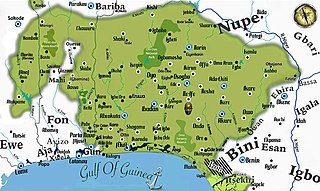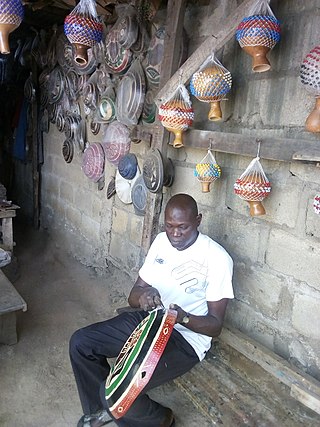Related Research Articles

Ogbomosho is a city in Oyo State, south-western Nigeria. It was founded in the mid 17th century. The population was approximately 655,517 in 2024. It is the second largest city in Oyo State and also among the most populated in Nigeria. It is the 3rd most populated city in South Western Nigeria after Lagos and Ibadan. Although the principal inhabitants of the city are the Yoruba people, there are people from other parts of Nigeria and other West African countries who are residents in the city.

Ilorin is the capital city of Kwara State located in the North-central region of Nigeria, although dominated by Yorubas, it is classified as North-central state due to its emirate system of traditional rule. As of the 2006 census, it had a population of 777,667, making it the 7th largest city by population in Nigeria.

Yorubaland is the homeland and cultural region of the Yoruba people in West Africa. It spans the modern-day countries of Nigeria, Togo and Benin, and covers a total land area of 142,114 km2 (54,871 sq mi). Of this land area, 106,016 km2 (74.6%) lies within Nigeria, 18.9% in Benin, and the remaining 6.5% is in Togo. Prior to European colonization, a portion of this area was known as Yoruba country. The geo-cultural space contains an estimated 55 million people, the majority of this population being ethnic Yoruba.

The Oyo Empire was a Yoruba empire in West Africa. It was located in present-day southern Benin and western Nigeria. The empire grew to become the largest Yoruba-speaking state through the organizational and administrative efforts of the Yoruba people, trade, as well as the military use of cavalry. The Oyo Empire was one of the most politically important states in Western Africa from the mid-17th to the late 18th century and held sway not only over most of the other kingdoms in Yorubaland, but also over nearby African states, notably the Fon Kingdom of Dahomey in the modern Republic of Benin on its west.
Obadiah Johnson was a Saro who was both the second Nigerian to qualify as a medical doctor and the co-author, with his brother the Reverend Samuel Johnson, of A History of the Yorubas from the Earliest Times to the Beginning of the British Protectorate.
Ajagbo was an Alaafin of the West African Oyo Empire, whose long reign took place during the seventeenth century.

Oyo is a city in Oyo State, Nigeria. It was founded as the capital of the remnant of the historic Oyo empire in the 1830s, and is known to its people as 'New Oyo' to distinguish it from the former capital to the north, 'Old Oyo' (Ọ̀yọ́-Ilé), which had been deserted as a result of the Yoruba Revolutionary Wars. Its inhabitants are mostly of the Yoruba people, and its ruler is the Alaafin of Oyo.
Bashorun Gaha was a notable nobleman and leader of the military in the old Oyo Empire during the 18th century. From 1650 to 1750, Oyo Empire was at the pinnacle of its greatness, peace, prosperity and wealth. The Empire had expanded to the utmost part covering the river Niger in the north; part of Tapa and Bariba kingdoms in the East of the lower Niger; towards the South by the seacoast and the West including Popos and Dahomey. Thousands of provincial officials were appointed to administer all the conquered kingdoms and report to the Alafin who glory in his majesty and power. Women, men, young and old sang his praises. Then internal struggles for power began the rapid acceleration of the Empire disintegration and total collapse.
The Ilorin Emirate is a traditional state based in the city of Ilorin in Kwara State, Nigeria. It is largely populated by the Yoruba-speaking people, though the kingdom is a hybrid state due to the influence of the many other tribes that make up the city.
Afonja of Ilorin was the "Are-Ona-Kakanfo", or chief military leader, of the Oyo Empire. Laderin, the great-grandfather of Afonja, was the founder of Ilorin city. He was succeeded by his son, Pasin, a powerful warrior who became a threat and target to, Basorun Gaha, because of his rising profile. He was driven into exile and killed. Alagbin, his son was made Baale. After the death of Alagbin, his son, Afonja, took over. These were the only four Yoruba baale in Ilorin.
The Jalumi War, also called the Battle of Ikirun, was a battle that took place on 1 November 1878 in the north east of present-day Osun State, Nigeria. It was part of the larger conflict named the Ibadan War. The forces of Ibadan were victorious in detail over a force of rebellious Yorubas including soldiers from Ilorin, Ekiti, Ila and Ijesha. Despite the victory, fighting continued in the years that followed until the Ilorins were finally defeated in 1897.
The Yoruba Revolutionary Wars, also known as the Yoruba Civil Wars, were a series of conflicts that engulfed the Yoruba-speaking areas of West Africa from approximately 1789 to 1893. These wars were characterized by intense and prolonged struggles among various Yoruba city-states and kingdoms, leading to significant political, social, and economic changes in the region.

The Oyo Mesi is the privy council of Oyo, a Yoruba traditional state in Southwestern Nigeria. It dates to the medieval period, when it served as the government of a powerful pre-colonial state that was known as the Oyo empire.
The Kiriji War, also known as the Ekiti–Parapo War, was a 16-year-long civil war between the subethnic kingdoms of the Yoruba people, specifically divided between the Western Yoruba, which was mainly the Ibadan and Oyo-speaking Yorubas, and the Eastern Yoruba, who were the Ekiti people, Ijesha, Ijebu people, and others.

Obadoke Latoosa Oyatoosa, but more commonly referred to as Latoosa, and later Mohammed Obadoke Latoosa, was a Yoruba General, Warlord, and Chief who was the Aare Ona Kakanfo of the Oyo Empire, the ruler of the self proclaimed Ibadan Empire, and the commander and leader of the Western forces of Ibadan during the Kiriji War from 1877 to his death in 1885.
Alaafin Atiba Atobatele was a king of the Oyo Empire. He was the son of King Abiodun of Oyo, and Eni-olufan from Akeitan.
Orile Ijaye is a small town located in Akinyele local government, Oyo state, Nigeria. It is about 18 miles from Ibadan, Oyo state capital. This town was re-inhabited in 1895, 32 years after it was destroyed due to an intra-ethnic and supremacy war with Ibadan; another military power at that time. The name of the town came from the original name, Ijaye, the name meaning Ijaye city-town.
The Battle of Ilorin occurred during the 1830's as part of a series of conflicts during the Yoruba Civil Wars. Toyeje, previously the Bale of Ogbomosho and commander of the late Kakanfo's right, was elevated to the position of Kakanfo. He rallied forces to expel the Fulanis from Ilorin. They established a camp at Ogele, where they faced Fulani horsemen who were being supported by the Yoruba Muslim leader, Solagberu of Oke Suna.
The Mugbamugba war was the second attempt of Yoruba's to expel the Fulanis and recover Ilorin.
The Battle of Pamo took place in Nigeria in the 1830's, when the Fulani under Solagberu defeated the Yoruba.
References
- ↑ Johnson, Samuel (1956). The History of the Yorubas: From the Earliest Times to the Beginning of the British Protectorate. C.M.S. (Nigeria) Bookshops.
- ↑ Johnson, Samuel (2010). Johnson, Obadiah (ed.). The History of the Yorubas: From the Earliest Times to the Beginning of the British Protectorate. Cambridge Library Collection - African Studies. Cambridge: Cambridge University Press. ISBN 978-1-108-02099-2.
- ↑ The History of the Yorubas